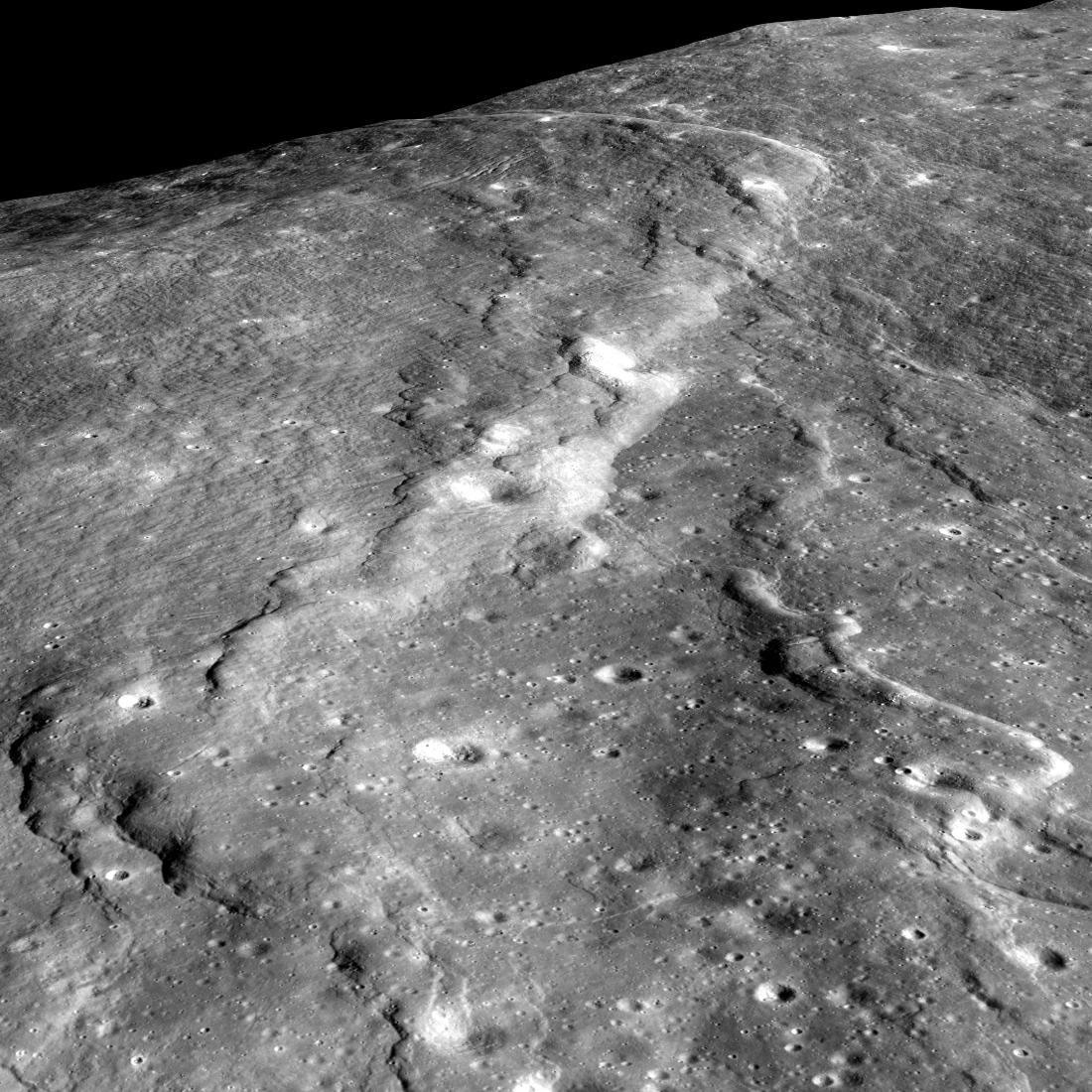
Today's Featured Image is a frame from a video made up of Lunar Reconnaissance Orbiter Camera (LROC) Narrow-Angle Camera (NAC) images. The images were draped over a Digital Terrain Model (DTM) based on precise elevation data from the Lunar Reconnaissance Orbiter (LRO) Lunar Orbiting Laser Altimeter (LOLA) instrument and analysis of LROC NAC image pairs. The result: a virtual flyover of a fascinating lunar feature.
The video - and our Featured Image - display a small complex of lobate scarps, part of a string of similar scarps that stretches across the lunar farside craters d'Alembert and Slipher. Make sure you have your speakers on, and click to begin the flyover.
Scientists discovered lobate scarps almost a half-century ago while studying Apollo Panoramic Camera photos. Taken in near-equatorial lunar orbit by Apollo astronauts, the photos only hinted at the nature and extent of lobate scarps.
LROC geologists discovered the d'Alembert scarps highlighted in this Featured Image after LRO reached the Moon in June 2009. From polar orbit, LROC's Narrow Angle Camera instrument can image the entire Moon in greater detail than ever before. LRO's long lifespan means we have been able to capture many images under the low-angle lighting conditions that best highlight lobate scarps. We now know of more than 3200 lobate scarps scattered over lunar surface from pole to pole, with more discovered all the time.
Astronauts have visited just one lobate scarp. Apollo 17 Commander Eugene Cernan and Lunar Module Pilot Jack Schmitt drove their Lunar Roving Vehicle across Lee-Lincoln scarp in December 1972. At the time, Lee-Lincoln's geologic significance was not understood.
What are lobate scarps? How do they form? Lobate scarps are a sign that the Moon is still warm inside, but is cooling as it ages. As the interior cools, it shrinks, leaving the brittle crust without support. Gravity tugs on the crust until it snaps, forming a thrust fault. Part of the top layer of the crust - the regolith - rides up and over another part. From above, we see a steep scarp face, and, behind the scarp face, a gentle slope. A lobate scarp is born.
The d'Alembert scarp face is about 25 meters high. The average lobate scarp face stands about 40 meters high.
Over time, the thrust faults underlying the d'Alembert lobate scarps probably shift both suddenly and gradually. Fault movement causes moonquakes that shake - and shape - the lobate scarps and surrounding areas.
The gentle slopes behind the d'Alembert scarp face, for example, include ditch-like features called graben. As you watch the flyover video, be sure to look for short, skinny grooves. Graben are faults that form when the crust is extended - that is, stretched. Lobate scarps form through compression, but it is not hard to picture how the slowly flexing, hinging surface behind the steep scarp could undergo local extension.
The graben are important because they are a sign that lobate scarps are geologically young. Some lobate scarp graben are only a meter deep, so they will not last long before surface shaking from nearby meteoroid impacts and moonquakes fill them in. Geologists estimate that many lobate scarps are less than 100 million years old.
Related Featured Images
Investigating Newly Discovered Lobate Scarps This overview of a very recent study includes a graphic of an idealized lobate scarp thrust fault.
The Moon in 3D An anaglyph image from LRO's earliest days in lunar orbit (July 2009) of the Lee-Lincoln Scarp at the Apollo 17 landing site.
Lunar Lobate Scarp A small crater within the crater Xenophanes is home to a nearly straight north-south lobate scarp.
Slipher Crater: Fractured Moon in 3D Slipher crater is inside d'Alembert crater and its lobate scarp system links to the d'Alembert lobate scarp system.
Numerov's Graben The crater Numerov contains a lobate scarp with graben.
Sources
Watters, T. R., Robinson, M. S., Beyer, R. A., Banks, M. E., Bell, J. F., Pritchard, M. E., Hiesinger, H., van der Bogert, C. H., Thomas, P. C., Turtle, E. P., and Williams, N. R. (2010), Evidence of Recent Thrust Faulting on the Moon Revealed by the Lunar Reconnaissance Orbiter Camera. Science 329, 936-940
Watters, T. R., Robinson, M. S., Banks, M. E., Tran, T., Denevi, B. W. (2012), Recent extensional tectonics on the Moon revealed by the Lunar Reconnaissance Orbiter Camera. Nature Geoscience 5, 181-185
Clark, J. D., Hurtado, J. M., Hiesinger, H., van der Bogert, C. H., Bernhardt, H. (2017), Investigation of newly discovered lobate scarps: Implications for the tectonic and thermal evolution of the Moon. Icarus 298, 78-88
van der Bogert, C. H., Clark, J. D., Hiesinger, H., Banks, M. E., Watters, T. R., Robinson, M. S. (2018), How old are lunar lobate scarps? 1. Seismic resetting of crater size frequency distributions, Icarus 306, 225-242
Published by David Portree on 31 October 2018